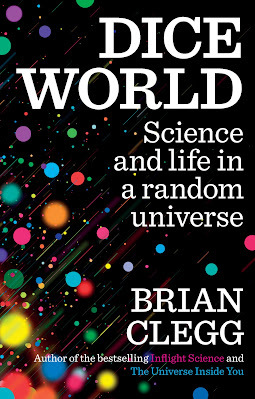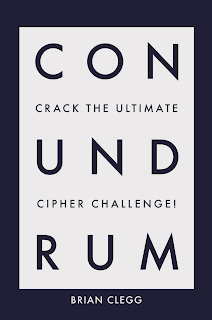Brian Clegg's Blog, page 6
March 10, 2025
Not Monty Python... the other one
 A book I'm currently reading (
Proof
by Adam Kucharski) starts by introducing the Monty Hall problem and adds a piece of info I wasn't aware of. It's my favourite example of the counter-intuitive nature of probability, featuring at some length in my book Dice World, so I thought it worth revisiting here.
A book I'm currently reading (
Proof
by Adam Kucharski) starts by introducing the Monty Hall problem and adds a piece of info I wasn't aware of. It's my favourite example of the counter-intuitive nature of probability, featuring at some length in my book Dice World, so I thought it worth revisiting here.The problem (of which more in a moment) gained worldwide fame when it featured in the 'Ask Marilyn' column in Parade Magazine in 1990. The column was written by Marilyn vos Savant, whose claim to fame was appearing in the Guinness Book of Records as the person with the highest IQ in the world. (She was born Marilyn Mach, but despite appearing to have a phoney attempt to get the word 'savant' into her name, vos Savant was her mother's surname.) What was remarkable about the problem was that so many people - some of them mathematicians and professors - got it wrong. It is fascinating now to look back and see some of the letters published in Parade saying what a terrible mistake vos Savant made.
The thing I discovered in Proof is that that the great mathematician Paul Erdós would not initially accept the correct answer because the person describing the problem to him could not adequately explain why it is the correct answer. The mathematician believed that for something to be proved it had to be explained too. I've tried various explanations over the years, but I added one in my book Game Theory, so I wanted to bring that into the mix - and also to make use of a live version of the game for your entertainment.
If you already know the problem, you might like to skip the next bit. It is based on the game that ended the quiz show Let's Make a Deal, hosted by Monty Hall. In the version described by vos Savant, the winning contestant is given a choice of three doors. Two have goats behind them, one has a car. It's a purely random choice, so when the contestant picks a door - say door 2 - there is a 1 in 3 chance they are right and a 2 in 3 chance they are wrong. The game show host now opens one of the other doors and shows a goat. Finally the contestant is given a choice. Would they like to stick with the door they have, or switch to the other unopened door? The question is, should they stick, should they switch, or does it not matter (probability wise) which they do?
Here's the game in action:
My audience was unusual, but the vast majority of people can see this is very simple. There are two doors available (because we can discount the one the host opened with a goat behind it). One has a goat, one has a car. So it's 50:50 which will be right. This means it doesn't matter if you stick or switch.
The vast majority of people are wrong. You will double your chances of winning if you switch.
Here's one explanation of why. Remember at the start, there was a 2 in 3 chance the car was behind one of the other two doors. All the game show host does is show you which of those two not to choose - but there is still a 2 in 3 chance the car is there. So you ought to switch. This only works because the game show host has information you don't. He selected a door he knew to have a goat behind it.
Here’s the game theory take on the Monty Hall problem, assuming that the player initially selects door 1, which is how the problem was first posed. If the player switches, they will always switch to the door the host didn’t open, as otherwise they are definitely switching to a goat:

If, despite these arguments, you don't find it convincing you are not alone. I remember when the problem was first publicized many of us wrote little computer simulations to prove the outcome. And it's right. Switch and you have a 2 in 3 chance of winning. But, as I mentioned, the most fascinating thing were the irate letters vos Savant received and reproduced. Here are some of my favourites (I have replaced names with initials to avoid any blushes). I particularly love the last one:I'll come straight to the point... you blew it! [repeats the problem] Let me explain: if one door is shown to be a loser that information changes the probability to 1/2. As a professional mathematician, I'm very concerned with the general public's lack of mathematical skills. Please help by confessing your error and, in the future, being more careful. - R. S. PhD, George Mason University, Fairfax, Va.You blew it, and you blew it big! I'll explain: After the host reveals a goat, you now have a one-in-two chance of being correct. Whether you change your answer or not the odds are the same. There is enough mathematical illiteracy in this country, and we don't need the world's highest IQ propagating more. Shame! - S. S. PhD, University of FloridaI have been a faithful reader of your column and have not, until now, had any reason to doubt you. However, in this matter, in which I do have expertise, your answer is clearly at odds with the truth. - J. R. PhD, Millikin UniversityMay I suggest you obtain and refer to a standard textbook on probability before you try to answer a question of this type again? - C. R. PhD, University of FloridaYour logic is in error, and I am sure you will receive many letters on this topic from high school and college students. Perhaps you should keep a few addresses for help with future columns. - W. R. S. PhD, Georgia State UniversityYou are utterly incorrect about the game show question, and I hope this controversy will call some public attention to the serious national crisis in mathematical education. If you can admit your error, you will have contributed toward the solution of a deplorable situation. How many irate mathematicians are needed to get you to change your mind? - E. R. B. PhD, Georgetown UniversityYou're wrong, but look at the positive side. If all those Ph.D.s were wrong, the country would be in very serious trouble. - E. H. PhD, US Army Research Institute
These articles will always be free - but if you'd like to support my online work, consider buying a virtual coffee or taking out a membership:
See all Brian's online articles or subscribe to a weekly email free hereMarch 8, 2025
Should science writers (and scientists) be globe-trotting?
 In their The Studies Show podcast The Science of Johann Hari, the excellent Stuart Ritchie and Tom Chivers point out the entertaining way the blurbs for former journalist Hari's books boast about his epic journeys to interview scientists. These include 'Confused, he set out on a three-year, thirty-thousand mile journey to discover what really causes addiction - and how to solve it.' (Chasing the Scream) and 'Finding the answer to this high-stakes question led him on a journey from Iceland to Minneapolis to Tokyo...' (Magic Pill). Ritchie and Chivers also include a claim for another book with a forty-thousand mile journey, though this seems to have disappeared.
In their The Studies Show podcast The Science of Johann Hari, the excellent Stuart Ritchie and Tom Chivers point out the entertaining way the blurbs for former journalist Hari's books boast about his epic journeys to interview scientists. These include 'Confused, he set out on a three-year, thirty-thousand mile journey to discover what really causes addiction - and how to solve it.' (Chasing the Scream) and 'Finding the answer to this high-stakes question led him on a journey from Iceland to Minneapolis to Tokyo...' (Magic Pill). Ritchie and Chivers also include a claim for another book with a forty-thousand mile journey, though this seems to have disappeared.The podcasters point out that these 'epic journeys' seem to have consisted of flying to a few places to interview people. But I think there's a more worrying issue in a globally heating world - what was the point of making the journeys in the first place? All he appears to have done was interview people. I have interviewed people around the world, but I have not flown for over 25 years. For example, back in 2013 I interviewed the late Steven Weinberg for a piece in the Observer. No flying was required. It may be a surprise to epic journey takers, but we have these amazing devices now called telephones and video calls.
If I'm honest, I think we can broaden this not just to other science writers and journalists, but also to scientists in general. It feels decidedly hypocritical when climate scientists in particular travel around the world to attend a conference, but the same applies to all scientists. (In fact, all academic disciplines.) Incidentally, it's strange how often conferences are in exotic locations that don't necessarily have any connection to the topic. Of course there are many legitimate reasons for writers and scientists to fly. It may be to get to the right place to undertake an experiment, or to investigate something that is happening, for example. But it is hard to justify doing so just to talk to other people.
I accept that calls and video conferences are not quite as good as being there in person. But this is a matter of balancing the positive and negative impact. When those of us who write about science or undertake it make long-distance travel to have conversations part of our jobs, we are, like it or not, setting a visible example that climate change doesn't really matter. It's surely time that we put globe-trotting behind us if we really believe there is a global heating crisis.
Image from Unsplash by Leio MclarenThis has been a Green Heretic production. See all my Green Heretic articles here.
These articles will always be free - but if you'd like to support my online work, consider buying a virtual coffee or taking out a membership:
See all Brian's online articles or subscribe to a weekly email free hereMarch 4, 2025
A Scandalous Affair - Leonard Goldberg ****
 This is Sherlock Holmes, the next generation - with Holmes' daughter Joanna centre stage. Despite the cover, where she appears about 12, presumably to appeal to Enola Holmes fans, she is now Mrs Watson, married to John Watson's son who narrates the story. As this is her second marriage and has a 17-year-old son we can assume Joanna is at least in her late 30s.
This is Sherlock Holmes, the next generation - with Holmes' daughter Joanna centre stage. Despite the cover, where she appears about 12, presumably to appeal to Enola Holmes fans, she is now Mrs Watson, married to John Watson's son who narrates the story. As this is her second marriage and has a 17-year-old son we can assume Joanna is at least in her late 30s. Watson senior is still around, if elderly (Sherlock being long gone), while Mr & Mrs Watson live at 221B Baker Street, looked after by one Miss Hudson... and there's even a son-of-Lestrade at Scotland Yard.
The plot centres on an increasingly dubious blackmail featuring the scandalous behaviour of the Chancellor of the Exchequer's granddaughter, which Joanna solves with rather more equanimity than her father, if exhibiting many of his traits. Along the way we are plunged into opium dens, a break-in to a suspect's mansion, theatrical goings on, scientific experiments and more. Leonard Goldberg is a doctor and gives us more medical content that was the case with the original - indeed appropriate, given Watson junior like his father is a doctor (but in his case, a pathologist).
It's a nice idea and an enjoyable light read. Goldberg is American, but puts across a good Sherlockian London vibe. The only slight problem with this is that the setting is now 1918, not Victorian England. The mode of speech feels too Victorian for the period - by 1918, it would have been rather closer to P. G. Wodehouse than Doyle. Wodehouse's Bertie Wooster was in the habit of popping over to Le Touquet to play the casino, which highlights one of a few anachronisms - early on, for example, we hear that they've checked all the major casinos [in London] - that would have been all zero of them, as they weren't legalised in the UK until the 1960s.
Another example of the Victorian theme lingering into the future is that we're told there are many opium dens in London, where actually they had gone by the end of the nineteenth century. Goldberg brings in a Doyle character in opium den owner Ah Sing - he was a real person, but had died, along with his trade, well before 1900. Although Goldberg largely gives us reasonable usage of the period, some Americanisms creep in: for example, calling a barman a barkeep, a fire engine a fire truck, referring to the ground floor as the first floor and calling a bowler hat a derby. Most bizarrely ‘stoker’ is employed as the word for a poker - a usage not in the OED. Though occasionally a trifle disconcerting, these aren't too much of an issue.
The book was compared in a write-up to Anthony Horowitz's Holmes novel House of Silk, which also features opium dens. Horowitz is a slicker writer with an appropriate Victorian setting - I might have preferred his book as a clever piece of writing, but this is lighter, more fast paced and certainly readable.
You can buy A Scandalous Affair from Amazon.co.uk and Amazon.com
Using these links earns us commission at no cost to youThese articles will always be free - but if you'd like to support my online work, consider buying a virtual coffee or taking out a membership:Review by Brian Clegg - See all Brian's online articles or subscribe to a weekly email free hereMarch 1, 2025
AI and book contracts
 Anyone who has ever had a book traditionally published knows the joys of reading through a publisher's contract. There are some bits that make you wince (the part where they throw you to the dogs if they get sued, for example), and others that are quite pleasing (usually involving money). I've seen a good few contracts in my time, both mine and those for other authors who have asked me to cast an eye over them. (If there's anything too complex, I strongly advise authors to join the Society of Authors and make use of their checking service.) Of late, I've seen AI starting to rear its head in new clauses - and it has been a pleasant surprise.
Anyone who has ever had a book traditionally published knows the joys of reading through a publisher's contract. There are some bits that make you wince (the part where they throw you to the dogs if they get sued, for example), and others that are quite pleasing (usually involving money). I've seen a good few contracts in my time, both mine and those for other authors who have asked me to cast an eye over them. (If there's anything too complex, I strongly advise authors to join the Society of Authors and make use of their checking service.) Of late, I've seen AI starting to rear its head in new clauses - and it has been a pleasant surprise.When publishers started mentioning AI in contracts, I assumed we were talking about clauses that banned authors from using generative AI to write their books for them - and, not surprisingly, they have started to appear. (Publishers need to be careful with this one, as the contracts do need to allow the inclusion of content from AI sources as long as it's to illustrate the work of AI and labelled as such.)
But the pleasant bit is that I have also started to see clauses where the publishers themselves promise not to make use of AI in various aspects of the publishing. Here are the kind of things I've seen:
The Publisher and the Author have a mutual interest in protecting human creativity and ensuring that their respective interests in the Work are not undermined through the detrimental use of Artificial Intelligence.The Publisher shall not use Artificial Intelligence technology to adapt the Work or create new content within the Work.The Publisher undertakes that the cover and illustration (if any) and cover copy for the Work shall be primarily the creative work of a human. The Publisher agrees not to use AI-generated images, artwork, design, and other visual elements for the book cover or interior artwork without the Author’s prior express approval.The Author will not license the Work for generative AI and development of machine learning models without the Publisher’s approval. The Publisher shall not input, provide or otherwise use the whole or any part of the Work into any Artificial Intelligence technologies for the purpose of training any such technologies or for any other related purpose.Like most legalise, it doesn't feel as simple as it ought to be. Yet it is, surely a step in the right direction. I don't know how my agreeing not to licence AI training in a contract with a publisher would prevent my work being used in this way without my knowledge... but it feels a positive move overall and I hope all publishers will be adopting a supportive approach to their authors.There is currently a campaign in the UK Make IT Fair to stand against UK government moves to change the law to make it easier for tech companies to use British creative content in AI training without permission or payment. Find out more here, where there's a link to write to your MP.
I intended to illustrate this article with a picture of a computer tearing up a contract, produced by generative AI, which seemed amusingly ironic. But once I did it, it felt uncomfortable, so you'll have to use your own creativity to envision this. To be honest, it wasn't a very good image anyway.
These articles will always be free - but if you'd like to support my online work, consider buying a virtual coffee or taking out a membership:
See all Brian's online articles or subscribe to a weekly email free hereFebruary 24, 2025
My hybrid car confusion
 No, I know that picture is not a hybrid car: bear with me.
No, I know that picture is not a hybrid car: bear with me.I have just started the process of buying a plug-in hybrid car. In principle, I'd love to go for the full electric experience, but there are still problems, as I had the opportunity to point out on Newsnight recently. Electric cars are still too expensive - but the same is true of plug-in hybrids. More significantly, there are range issues and the charging infrastructure is both far too sparse and pricey.
My driving pattern consists of a combination of local driving, which the electric part of a modern plug-in hybrid can entirely cover, and 300 mileish round trips, much of it spent in places where chargers are very few and far between - which is why I still need the petrol side.
For the moment, then, I think I've made the right choice. But I embarrassingly realised when taking a look through the manual for the car I am yet to pick up (yes, I'm the sort of person who reads manuals) that I totally misunderstood how most hybrids work. The blame lies firmly with my teenage enthusiasm for trains.
By my mid-teens I'd got past the trainspotting stage, but loved taking train journeys for the sake of it. If I'd been a bit older, part of the enthusiasm would have been steam locomotives - but I was very much of the diesel age, with my favourite engines to travel behind being Deltics (one pictured above) and Westerns. Westerns ran on what had been the GWR - a region of British Rail that retained the eccentric individuality of Isambard Kingdom Brunel by using diesel hydraulic engines. The output of their diesel engines was transmitted to the wheels by a hydraulic transmission. But Deltics followed the far more common mechanism of being diesel electric.
What this meant was that a Deltic's vast diesel engines generated electricity to power its electric motors. When introduced, Deltics were the most powerful single unit diesel locomotives in the world - the rumble of power they made was music to the ear of train lover. The locomotives contained two Deltic diesel engines, originally designed for marine use.
With my familiarity with diesel electric locomotives, it just seemed obvious to me that hybrid cars used the petrol engine to generate electricity to feed electric drive motors. I even had this model in mind when I test drove one. But reading the manual, I discovered the petrol engine has an automatic gearbox. If the car had an electric transmission there would have been no need for a gearbox. The only possibility was that both the electric motor and the petrol engine drove the wheels. Doh. I still don't really understand why this is the case, as it seems unnecessarily complicated, but on looking into it, most hybrids have such 'parallel' setups rather being series hybrids. It just shows that this 'being greener' business remains quite complicated.
Image from Unsplash by Neil Mewes - the Deltic portrayed (on a preserved railway) carries the thistle emblem of the Flying Scotsman (train as opposed to locomotive), which I travelled on in my teens behind a Deltic.This has been a Green Heretic production. See all my Green Heretic articles here.
These articles will always be free - but if you'd like to support my online work, consider buying a virtual coffee or taking out a membership:
See all Brian's online articles or subscribe to a weekly email free hereFebruary 23, 2025
A Short Infinite Series #5 - my infinity's bigger than yours
 An infinite series is a familiar mathematical concept, where '...' effectively indicates 'don't ever stop' - for example 1 + ½ + ¼ + ⅛... an infinite series totalling 2. This, though is the last of a short series of posts about infinity.Apart from Galileo, as ever standing out from the crowd, pretty well anyone who had dealt with infinity was really handling the potential infinity mentioned by Aristotle – and that’s what the familiar curve of the lemniscate ∞ is the symbol for. Not really infinity, but potential infinity. Towards the end of the 19th century, though, one man took the plunge to think about the real thing. His name was Georg Cantor, and it has been suggested that he went mad as a result of it.
An infinite series is a familiar mathematical concept, where '...' effectively indicates 'don't ever stop' - for example 1 + ½ + ¼ + ⅛... an infinite series totalling 2. This, though is the last of a short series of posts about infinity.Apart from Galileo, as ever standing out from the crowd, pretty well anyone who had dealt with infinity was really handling the potential infinity mentioned by Aristotle – and that’s what the familiar curve of the lemniscate ∞ is the symbol for. Not really infinity, but potential infinity. Towards the end of the 19th century, though, one man took the plunge to think about the real thing. His name was Georg Cantor, and it has been suggested that he went mad as a result of it.Cantor was born in 1845 and spent all his working life at the university in Halle. This is a German town famous for music, but frankly not for maths. Cantor saw it as a stepping stone to greater things – and it probably would have been, had he not come up with some conclusions that were so mind-bending that at least one other mathematician would set out systematically to ruin his career.SetsCantor’s first great contribution was to formalise the mathematics of sets. Sets had been around really as long as people conceptualized – but Cantor embedded them firmly into mathematics. A set is really just a group of things. They could have something in common – like the set of things that look like an orange, or the set of people with the name Brian – or they could be as disparate as the set of things you thought about today. Cantor built on work of other mathematicians to pull together a picture of how sets operate that lets us do everything from define the numbers to establishing simple mathematical operations. But for our purposes I just want to pick out one aspect of set theory because it is going to be very relevant to the jump from sets to infinity. It’s a property of a set called its cardinality. Let’s think of a two very simple sets – the first is the set of legs on my daughter's dog. The second is the horsemen of the apocalypse. These two sets are said to have the same cardinality if I can pair of the members of the set on a one-to-one basis. Let’s try that.
Front right, for example could pair up with Death, Front left with Famine, Back right with Pestilence and Back left with War. I’ve exhausted both legs and horsemen, so they have the same cardinality. But – and here’s the clever thing – I needn’t have known how many legs the dog has or how many horsemen there are. Okay, in this example it’s no secret, but it wasn’t necessary to know. (can I just say that no animals were hurt in the making of that graphic).
With set theory in place, Cantor was ready to build on Galileo’s observations about the way that with infinity you could get one-to-one correspondence with a ‘smaller’ infinite set. Remember Galileo’s description of the integers, the counting numbers, and the squares. We can say that the infinite set of counting numbers has the same cardinality as the set of squares, because we can do that one-to-one pairing off, even though we don’t know how many we are dealing with.
And we know that the squares are a subset of the integers. Subset’s a spot of set theory that has escaped into the world, but specifically we mean that all the squares are members of the set integers, but it isn’t the full set – there are members that are squares. Cantor, cunningly, used this strange behaviour to define an infinite set. An infinite set is one that has a one-to-one correspondence with a subset.Aleph nullOnce we’re taking a set theory approach to infinity – and dealing with the true infinity, not Aristotle’s potential infinity – it’s useful to have a different symbol for it. Cantor chose aleph ℵ, the first letter of the Hebrew alphabet, and specifically he called the infinity of the counting numbers aleph zero or aleph null because we can’t assume that all infinities are same, so this is the basic infinity, the infinity of the counting numbers. Aleph null has some pretty strange qualities. We can add one to it and still end up with the same number. You can see why if you imagine doing the one-to-one correspondence starting with an extra value called x, then go on with the rest of the numbers.
What’s more, add aleph null to itself and you get aleph null. Again, we can imagine this happening by setting up a correspondence alternately with two lots of counting numbers. And for that matter you can multiply aleph null by itself – and still get aleph null. Imagine matching each of the numbers with its square. There are enough gaps left to take up all the remaining sets of aleph null.
Mind boggling though this behaviour is, we are actually used to special cases in arithmetic. After all, 0 + 0 = 0 and 1 x 1 = 1. And really we should hardly be surprised if the answer never changed, because surely there can be nothing bigger than infinity. Only that’s exactly what Cantor set out to prove wasn’t true. The cardinality of the rational fractionsWe’ve looked at aleph null squared, but Cantor wanted to check how flexible aleph null really was. He’d checked out the counting numbers, but how about fractions? He started with rational fractions, fractions made out of the ratio of whole numbers. Cantor was to prove that there were also aleph null of these using a delightfully neat proof that requires no maths. Imagine laying out every fraction there is in a huge table. In fact, to make it simple we’re actually repeating many of the fractions. If you look down the diagonal coloured in yellow in the image below, they’re all 1. It doesn’t matter that we’ve got redundancy, the table, continued for ever in both directions, has every single ratio in it.

Now what Cantor did was to set up a repeating path through the table. A simple, repeatable rule that enables us to work through the whole table. Finally, he puts each jump in one to one correspondence with a counting number. We’ve just proved that aleph null applies to the rational fractions as well – they have the same cardinality as the integers because we can match them one-to-one by going through this sequence. Incidentally, though the first one in the video below is the path Cantor used, it’s not the only one that exists. He could just as well have used the second one, for instance… the point is that there is a mechanism to set up a one-to-one correspondence. What about irrational fractions?Yet these aren’t the only sort of fractions. There are also the irrationals, the numbers that written as decimals go on for ever and ever – presumably to infinity. Do these also squeeze into aleph null? With another blindingly simple proof, Cantor was to show that this wasn’t the case. (I ought to make it clear that what comes next is not the actual proof, but illustrates how it works.)
Let’s imagine putting every single fraction, rational and irrational, between 0 and 1 into a list. If I could really achieve that, then I could use exactly the same one-to-one matching proof, matching each fraction against its position in the list, an so would prove this was another aleph null set. Now to work this proof I need to be able to study sequential numbers in the list. If I have them in order I can’t do that, as two numbers in order only differ right at the end of an infinity long set of digits – so I’m going to scramble the list and pick out the first few randomly selected numbers.
Now let’s look at the diagonal set of digits in those numbers. You could imagine this as a number in its own right: 0.220709 and so on. Now let’s add one to each digit. So instead of reading 0.220709, the diagonal is 0.331810 (9 flips over to zero).
Finally, let’s compare this new number with our original table. It’s not the first number, because they differ in the first digit. It’s not the second number, because they differ in the second digit. It’s not the third number. And so on. We have generated a number that doesn’t appear in our list. Cantor had proved with beautiful simplicity that you can’t cram all the fractions between 0 and 1 into a list with cardinality aleph null. The count of these fractions was something bigger, something bigger than infinity. Take a moment to think about that.
Infinity, as people never fail to delight in telling me, is a very big subject. You can read far more in A Brief History of Infinity, which is available from Amazon.co.uk, Amazon.com and Bookshop.orgUsing these links earns us commission at no cost to youImage from Unsplash by Steve Johnson - not this infinity!These articles will always be free - but if you'd like to support my online work, consider buying a virtual coffee or taking out a membership:Article by Brian Clegg - See all Brian's online articles or subscribe to a weekly email free here
February 19, 2025
Coffees and memberships
 Thank you so much to everyone who has already used the 'Buy me a Coffee' link below to support my online book reviews, general science and writing life articles.
Thank you so much to everyone who has already used the 'Buy me a Coffee' link below to support my online book reviews, general science and writing life articles.As it says below, my posts on the Popular Science website and here on my blog Now Appearing will always be free, but if you'd really like to help keep me going (and to avoid running intrusive adverts, which I hate) I've introduced a membership scheme that involves a small monthly contribution.
There are three levels:
Bronze - £1 a month (or £10 a year), like the individual coffee purchases, this will help me be able to dedicate the time to writing these posts and reviews, but makes it more secure.Silver - £3 a month (or £30 a year) - by moving up to a coffee a month, I'm adding in additional posts and messages just for silver and gold members, plus discounts on signed books. Membership also includes the option to suggest books for review. There will be still be as many free posts for all readers, but there will be some tasty extras for members.Gold - £5 a month (or £50 a year) - in addition to the Silver benefits you will get a free, signed hardback book (or two paperbacks) at the start of the year if paying the full year, or at the end of the year if paying monthly. You will be given a choice from at least five titles each time, with the book(s) posted to your chosen address.I hope you will consider helping support my online writing - just click the 'Buy me a Coffee' button below.These articles will always be free - but if you'd like to support my online work, consider buying a virtual coffee:
See all Brian's online articles or subscribe to a weekly email free hereFebruary 17, 2025
AI and search engines - a dodgy combo?

Search engines are central to our everyday use of the internet - I must use a well-known search engine beginning with G at least a dozen times a day. But the search providers are displaying a worrying trend. Swept along by the enthusiasm for artificial intelligence, most have begun to display or offer an AI summary - in Google's case, this is the first thing you see at the top of the search results. And like all generative AI responses, it doesn't necessarily get it right.
This is quite easy to demonstrate if you make use of a query that pushes the boundary a little. I happened to be writing something about the BICEP2 telescope, located at the South Pole. So, interested to see how the AI would handle it, I asked 'Why was the BICEP2 telescope built at the South Pole?' This is quite a tricky question for an AI to handle - and Google's response demonstrated this powerfully. (The highlighting above was already there, it's not from me.)
It's certainly a good guess that you might locate a telescope at the South Pole because it's dark there, at least for six months of the year, with no light pollution. The problem is, though, that the (now replaced) BICEP2 was a radio/microwave telescope - and a lack of background signals in this part of the electromagnetic spectrum is not described as being dark.
But the real disaster in the confident result produced is that final sentence. The location did not help the telescope to detect primordial gravitational waves - admittedly they did announce that they had... but then they had to withdraw the claim within weeks when it turned out to be a result of polarisation from impact with dust. That final sentence is pure fiction.
Admittedly there is a small print warning that 'Generative AI is experimental' - but that isn't the same as saying that it can't be trusted (and anyway you only see it if you click a drop down to expand the original summary). By making the generative AI result the first thing you see - and let's face it, we're all lazy and often don't dig too far into a search result - there is a real danger that the software's potential for imaginings and hallucinations will be taken as an effective source of information. Surely that's not great?
These articles will always be free - but if you'd like to support my online work, consider buying a virtual coffee:Article by Brian Clegg - See all Brian's online articles or subscribe to a weekly email free here
February 15, 2025
A Short Infinite Series #4 - Galileo's musing
 An infinite series is a familiar mathematical concept, where '...' effectively indicates 'don't ever stop' - for example 1 + ½ + ¼ + ⅛... an infinite series totalling 2. This, though is a short series of posts about infinity.We're going to take a look at Galileo's surprisingly insightfulcontribution to our understanding of infinity. Galileo Galilei was born in 1564, the son of a musician and scientific dabbler. He tends to be remembered for dropping balls of the Tower of Pisa, something which be probably didn't do (it’s only recorded many years later by his assistant) and for being locked up for daring to suggest that the Earth rotates around the Sun rather than the other way round (not exactly accurate historically). Also inventing the telescope (he didn't) and featuring in that Queen song. But he undertook some remarkable thinking on the subject of infinity.
An infinite series is a familiar mathematical concept, where '...' effectively indicates 'don't ever stop' - for example 1 + ½ + ¼ + ⅛... an infinite series totalling 2. This, though is a short series of posts about infinity.We're going to take a look at Galileo's surprisingly insightfulcontribution to our understanding of infinity. Galileo Galilei was born in 1564, the son of a musician and scientific dabbler. He tends to be remembered for dropping balls of the Tower of Pisa, something which be probably didn't do (it’s only recorded many years later by his assistant) and for being locked up for daring to suggest that the Earth rotates around the Sun rather than the other way round (not exactly accurate historically). Also inventing the telescope (he didn't) and featuring in that Queen song. But he undertook some remarkable thinking on the subject of infinity.It took place after his house arrest. Galileo had put together his masterpiece, Discourses and Mathematical Demonstrations Concerning Two New Sciences. He had real trouble getting this published – the Inquisition were not too keen after his previous book – and when it was eventually taken up by the great Dutch publisher Elsevier, Galileo expressed his great surprise that it had been published at all, which he claimed had never been his intention. The book took the form of a conversation between characters, and here, having wondered about what holds matter together, they have a diversion, just for the fun of it, into the nature of infinity. Galileo brings out a number of points, but I'll concentrate on two. The first involves the rotation of a pair of wheels. He starts with wheels with a few sides - in the example below I’ve made them hexagons. These are three dimensional shapes – imagine the hexagons are cut out of sheets of marble. The smaller hexagon is stuck to the larger one, and each of them rests on a rail. I've made a poor quality video below to illustrate this.
We roll the wheel along a little. I'm going to do it twice. First watch what the big wheel does, then the small wheel. The big wheel moves along the track by the length of one of its sides. But not only has the big wheel moved on by that distance, so has the small one. It has to. They’re fixed together. Yet the small one should only have rolled along the track by the distance of its smaller side. How did it achieve it? It lifts off the rail entirely. There’s a gap of just the right distance.
Now here’s the clever bit. Galileo imagined increasing the number of sides. The more sides, the more sets of small movements along the rail and small gaps you get. Now let’s imagine we take that number of sides to infinity. We end up with circular wheels. Again we roll the two wheels, joined together, along their respective rails. Again they both travel the same distance – in this case a quarter of the circumference of the big wheel. But look what’s happening. The rim of the big wheel has rolled out a quarter of its circumference on its track. The rim of the smaller wheel has rolled out a smaller quarter circumference, but the wheel has travelled the same distance, without ever leaving the track. There were no jumps, or at least so it seems.
Galileo imagined that as the smaller wheel turns there are an infinite number of infinitesimally small gaps, which add up to make the difference between the circumference of the wheel and the distance it moves. After letting this percolate through his brain in the background, Galileo’s thoughtfully challenged character, Simplicio, has a complaint. What Galileo seems to be saying (or technically Salviati, the character that is Galileo’s voice) is that there are an infinite number of points in one circular wheel and an infinite number of points in the other – but somehow, one infinity is bigger than the other.Salviati is rueful. That’s the way it is with infinity: a problem he reckons, of dealing with infinite quantities using our finite minds. And he goes on to show how this is perfectly normal behaviour once you are dealing with infinity.
The simple mathematical tool he uses to demonstrate this is the square (that’s the square of a number, not the shape). Salviati makes sure Simplicio knows what a square is – any number multiplied by itself. So, he imagines going through the integers, multiplying each one by itself. [It’s not rocket science. For every single integer there is a square. We’ve an infinite set of integers, and there’s an infinite set of squares in a one-to-one correspondence.
But here’s the rub. There are lots of numbers that aren’t squares of anything. So though there’s a square for every single number – an infinite set of them – there are even more individual numbers than there are squares. Arggh. Simplicio’s brain hurts, and it doesn’t surprise us. Galileo has spotted something very special about infinity. The normal rules of arithmetic don’t really apply to it. You can effectively have ‘smaller’ and ‘bigger’ infinities – one a subset of the other that are nonetheless the same size. We’ll come back to this in a big way in the final post of the series.
You can buy my book A Brief History of Infinity from Amazon.co.uk, Amazon.com and Bookshop.org
Using these links earns us commission at no cost to youImage from Unsplash by Paris Freeman These articles will always be free - but if you'd like to support my online work, consider buying a virtual coffee:Article by Brian Clegg - See all Brian's online articles or subscribe to a weekly email free hereFebruary 14, 2025
Up for a challenge? Take on the Conundrum bonus puzzle
 A while ago I wrote a book called
Conundrum
, which consists of 200 puzzles and ciphers - those who complete the entire book are entered in Conundrum's Hall of Fame, currently featuring just 17 impressive individuals worldwide. I occasionally set a bonus puzzle, open to all, with a free signed book as a prize.
A while ago I wrote a book called
Conundrum
, which consists of 200 puzzles and ciphers - those who complete the entire book are entered in Conundrum's Hall of Fame, currently featuring just 17 impressive individuals worldwide. I occasionally set a bonus puzzle, open to all, with a free signed book as a prize.This one comes in the form of a challenge requiring you to put together a number of different elements:
Passing under the seventh Duke, take the date of the crocodile, add the psalm number and divide by the verse to get the answer.
If you are up for the challenge, you can enter your solution on the website here (and see a couple of clues). One winning entrant will be chosen at random - entries to be in by the end of 28 February (GMT).
Please don't append your entries here - only using the form on the website. I look forward to your suggestions: please do let me know how you got to the answer too in your entry.
You can buy my book Conundrum from Amazon.co.uk, Amazon.com and Bookshop.org
Using these links earns us commission at no cost to you
These articles will always be free - but if you'd like to support my online work, consider buying a virtual coffee:Article by Brian Clegg - See all Brian's online articles or subscribe to a weekly email free here



